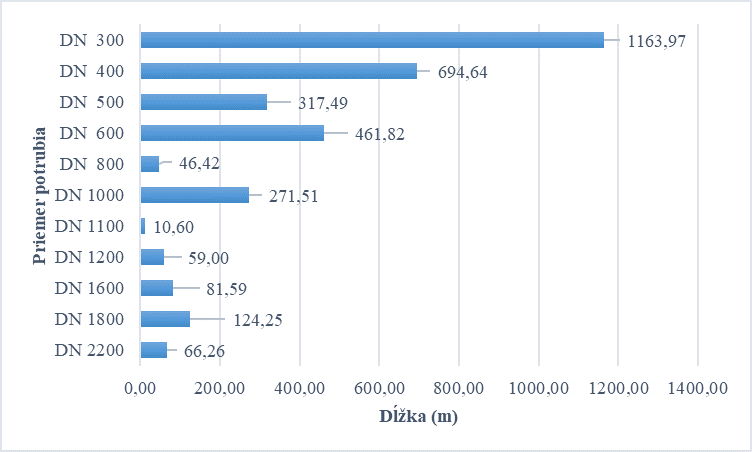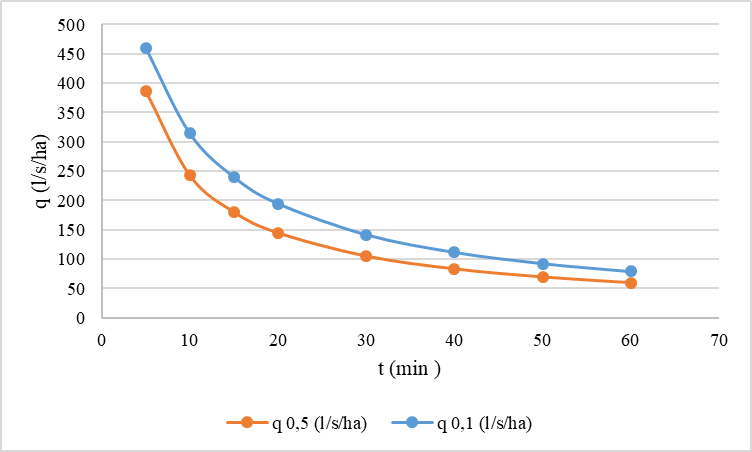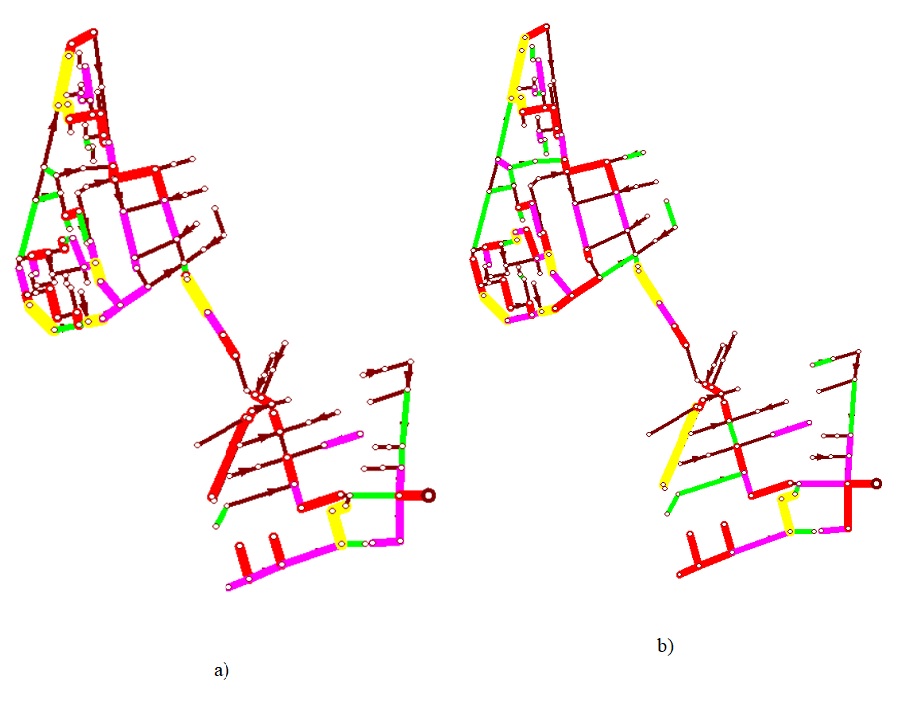The most of sewerage networks in Slovakia were built in the last century. Due to the increase in the number of inhabitants in towns and hydrological changes, it is necessary to re-evaluate sewerage networks' capacity. Overloading the network's hydraulic capacity can lead to the occurrence of urban floods, which are one of the negative impact of a high degree of urbanization. The aim of the paper was to assess the hydraulic conditions of a selected sewer collector in the city of Trnava. A mathematical model of the sewer network was created, which was used to simulate two different load cases with varying properties of precipitation. SCA's load state was characterized as a starting case, as the properties of the design rain corresponded to the design rain in the standard STN EN 75 6101. The simulation showed that 51.9% of the network has satisfactory conditions, and 48.1% of the network is congested. Under rain load with a periodicity of p = 0.1, the results were as follows: 41.9% of the network comply with the assessment, and 58.1% of the network was congested.
Réka Wittmanová, Štefan Stanko, Ivana Marko
Abstract
The most of sewerage networks in Slovakia were built in the last century. Due to the increase in the number of inhabitants in towns and hydrological changes, it is necessary to re-evaluate sewerage networks' capacity. Overloading the network's hydraulic capacity can lead to the occurrence of urban floods, which are one of the negative impact of a high degree of urbanization. The aim of the paper was to assess the hydraulic conditions of a selected sewer collector in the city of Trnava. A mathematical model of the sewer network was created, which was used to simulate two different load cases with varying properties of precipitation. SCA's load state was characterized as a starting case, as the properties of the design rain corresponded to the design rain in the standard STN EN 75 6101. The simulation showed that 51.9% of the network has satisfactory conditions, and 48.1% of the network is congested. Under rain load with a periodicity of p = 0.1, the results were as follows: 41.9% of the network comply with the assessment, and 58.1% of the network was congested.
Keywords
Hydraulic conditions, sewerage, sewer collector, heavy precipitation
Introduction
Sewerage networks are a fundamental element of the municipal drainage system, ensuring the health-friendly drainage of wastewater from urban areas and their treatment following guaranteeing the smooth operation of the hydrological regime of groundwater and surface water in the area [1].
With the gradual development of urbanized areas, the requirements for sewerage networks' properties have changed, reflected in the different types of systems used for drainage. The division of sewer systems is characterized on the basis of the class and method of discharged wastewater. There are three basic types of sewerage systems that carry wastewater together in one pipe or separately, namely: a combine sewerage system, which discharges all kinds of sewage through a common pipeline, a separate sewerage system, which discharges urban wastewater in a different network and the rain flow concentrated in the second piping system, the semi-separate sewer system consists of two separate piping systems [2].
The second half of the 20th century is characterized by the mass migration of the population and the development of urbanization and urban infrastructure. Urbanization is defined as a socio-economic process transforming the built environment of rural settlements into urban areas. It is also characterized by changes in the demographic and social structure of settlements and changes in the lifestyle and prevailing occupations of the population [3]. In the urban catchment area, several artificial elements affect the character of the surface runoff. The urban drainage system replaces part of the natural water cycle with synthetic components that are not identical. An excellent example of such a replacement is the strengthening of areas. At the same time, it is possible to observe an increase in surface runoff volume compared to the natural environment.
However, the natural process of the water cycle in the urbanized area is disturbed by many impervious areas, which contribute to the formation of surface runoff [4], [5]. With a high proportion of impervious areas in an urbanized area, the surface runoff wave is deformed, i.e. the concentration-time is shorter, but the total runoff volume is more extensive. Surface runoff is discharged from the urbanized area either by a single sewer network to the wastewater treatment plant or by a divided sewer network to the recipient. However, in torrential rains, the capacity of sewer networks may not be sufficient [6; 7; 8].
The sewerage networks in Slovakia were built in the last century. Due to the increase in the number of inhabitants in towns and hydrological changes, it is necessary to re-evaluate sewerage networks' capacity. Overloading the network's hydraulic capacity can lead to the occurrence of urban floods, which are one of the negative impact of a high degree of urbanization. They occur with a significant increase in the volume of rainwater discharged by extreme rainfall events [9]. Extreme precipitation events and the number of unacceptable areas in an urban environment cause an intensification of surface runoff [10]. Due to changes in the area hydrological characteristics caused by urbanization, there is also a concentration of surface runoff pollution and a change in the microclimate [11].
Insufficient hydraulic capacity is checked using models. These are numerical models simulating precipitation-runoff conditions of a given area. These models demonstrate simplified urban catchment systems.
The aim of this work is to approach the current problems in the operation of sewer networks during severe rain events. The modelled collector is part of the combined sewer network of Trnava and will be assessed by two load cases. The first load case will evaluate the network's current hydraulic conditions, and a 15-minute block rain with a periodicity of p = 0.5 will be used as the design rain. This design rain is also used in the design of sewer networks according to the standard STN EN 75 6101. The second load case will evaluate the network's hydraulic conditions under the action of rain with a periodicity of p = 0.1.
Description of the current state of the assessed network
The study deals with a selected part of the city of Trnava - six urban areas, which are located in two parts of the town (Trnava - West and Trnava - South). The population of the area of interest is around 20,495 (as of 31 December 2018). The total length of the sewer network of the area of interest is 3297.55 m.
The network of assessed sewers forms a branch system, and the primary collector is sewer G. The street sewers G1 - G9 are then further disconnected from the primary collector. The assessed network model ends at the site of the relief chamber OK 01 G, which empties into the river Trnávka. Sewage water is further discharged by the primary sewer collector B to the Trnava - Zeleneč WWTP wastewater treatment plant. The individual drains' pipe diameters range from DN 300 at the beginning of the sections to DN 2200 at the mouth into the combined sewer overflow chamber. Figure 1 shows the percentage of individual pipe diameters in the network. The smallest diameter is DN 300 and represents up to 35.3% of the network's total length. The pipes with the largest diameter (DN 2200) represent 2.01% of the network's total length.

Fig. 1 Inventory analysis of assessed collector pipe diameters
Study area surface analysis
When creating a combined sewer network model, it is necessary to define the height ratios of the area and its topology. The topology is given by the runoff coefficient, which characterizes the surface of the area. The assessed terrain falls under six urban districts of the city, covered by built-up areas - houses and BDs, roads, green belts, gardens, playgrounds with permeable areas, industrial zones with impermeable areas, parking lots, etc. The assessed area is located in a flat area, where the slope of the terrain is approx. 1%. This fact influenced the determination of runoff coefficients. Table 3 defines the runoff coefficients of the study area.
Tab. 1 Runoff coefficients of the study area

Determination of load cases
Sewer networks for residential areas are designed based on the standard STN EN 75 6101 Gravity sewerage systems outside buildings, which specifies the design rain as a 15-minute block rain with a periodicity of p = 0.5. We calculate the mathematical expression of the blocks of block rains based on data on block rains in Slovakia, which were determined by Šamaj and Valovič (1973) and using the equation for calculating the yield of block rains published in 1979 by Ucikán and Horváth [12]. For the first load case (SCA), a block rain with 15 minutes with a periodicity of p = 0.5 was selected, which represents the design condition according to STN EN 75 6101. The rain intensity was determined based on relations established by Šamaj and Valovič (1973), an equation for calculating the yield of block rains published in 1979 by Ucikán and Horváth [12]. The block rain of the first load case has an intensity of 180.39 l · s-1 · ha-1. A 15-minute block rain characterizes the second load case (SCB) with a periodicity of p = 0.1, and its intensity is 240.1 l · s-1 · ha-1.

Fig. 2 Block rain curves
Results
The impact of extreme precipitation on the sewer network is most often determined using models. These are numerical models simulating precipitation-runoff conditions of a given area. These models demonstrate simplified urban river basin systems. The sewer model was created using the SeWaCAD program, a software tool used for dimensioning and assessing a combined or separated sewer network. Based on the provided data - the hydro-technical situation of the sewer network, an essential network model was created, which was later supplemented by the surface analysis results and the design rain characteristics.
After creating the sewer network model and the implementation of the boundary conditions, simulations of load cases were performed. In the SCA load condition, the collector was loaded with a block rain lasting 15 minutes, with a periodicity p = 0.5 and an intensity of 180.39 l · s-1 · ha-1. In the SCB load case, the collision periodicity changed to p = 0.1, and its intensity was 240.1 l · s-1 · ha-1.

Fig. 3 Overloaded sections a) SCA, b) SCB
Fig. 3a presents the results of the assessment in the load state SCA and Fig. 3b results for the load case SCB. It shows individual congested sections, which are colour-coded according to the ratio of simulated flow and capacitive flow of the existing network. The ratio of simulated flow and capacitive flow of the existing network is expressed as a percentage. Green sections represent sewers overloaded to 100 - 150%, pink sections are overloaded to 150 - 250%, red sections to 250 - 500%, and yellow sections represent the most congested sewers (> 500%). Brown sections describe unloaded-satisfactory sections. Table 2 presents the lengths of overloaded sections for individual load cases and their percentage overload. When assessed for the SCA load condition, 1589.04 m of the network is congested, and 1712.32 m meets the assessment conditions. The SCB load condition results show that 1920 m of the network is congested, and 1381.02 m satisfies the assessment.
Tab. 2 Lengths of overloaded sections of the collector

Discussion
The total number of assessed sections of the network is 161. The SCA simulation showed that in the design rain according to the technical standard, 85 sections have satisfactory hydraulic conditions. The hydraulic capacity of 76 sections is unsatisfactory. At 100-150%, 16 sections are congested. The overload at 150 - 250% shows 23 sections and 250 - 500% up to 28 network sections. More than 500% of congestion was detected on nine sections of the network.
In SCB simulation, the following: 68 sections satisfy the assessment, and 93 sections are overloaded. Under this load condition, up to 13 sections are overloaded to more than 500%. The number of congested sections to 100-150% is 25, to 150-250% is 22, to 250-500% is 33 sections. Hrudka et al. (2020) also focused on their study on assessing the condition of sewer networks under various rains. The network's hydraulic capacity during rains was evaluated with periodicity p = 5, p = 0.5 and p = 0.2. In conclusion, it is stated that the possibility of reconstruction and renewal of the assessed sewerage network needs to be reconsidered [13].
Based on the simulations (SCA and SCB) results, it can be argued that the selected sewer shows unacceptable changes in hydraulic conditions already under SCA load. In an SCB load condition, it is possible to observe deteriorating loading conditions with a more intense crash event.
Conclusion
The aim of the paper was to assess the hydraulic conditions of a selected sewer network in the city of Trnava. It is well known that this city has long struggled with the adverse effects of urbanization. These unfavourable conditions also include the gradual urbanization of the area, increasing development and the occurrence of impervious areas. These conditions can cause urban floods, which can jeopardize several parts of the city's infrastructure. In this study, we presented a methodology for assessing the hydraulic conditions of sewer networks using SeWaCAD software.
A mathematical model of the sewer network was created, which was used to simulate two different load cases with varying properties of precipitation. SCA's load state was characterized as a starting case, as the properties of the design rain corresponded to the design rain in the standard STN EN 75 6101. The simulation showed that 51.9% of the network has satisfactory conditions, and 48.1% of the network is congested. Under rain load with a periodicity of p = 0.1, the results were as follows: 41.9% of the network comply with the assessment, and 58.1% of the network was congested. Most sewer networks in Slovakia were designed by rapid drainage of sewage and rainwater from urban areas. At present, the question arises as to whether this concept is correct. Due to climate change and anthropogenic activity, our cities are becoming risky microclimatic areas. By re-evaluating the old idea of rainwater drainage and using new nature-friendly measures to reduce rainwater's inflow into the network, it is possible to return water to cities and reduce sewer networks' congestion.
References
- HLAVÍNEK, P., DRTIL, M. Technologický projekt - časť Stokovanie. Bratislava : Slovenská technická univerzita v Bratislave, 2010.
- URCIKÁN, P., RUSNÁK, D. Stokovanie a čistenie odpadových vôd. Stokovanie I. Navrhovanie stokových sietí. Bratislava : Slovenská technická univerzita v Bratislave, 2004. ISBN 80-227-2136-0.
- United Nations, Department of Economic and Social Affairs, Population Division. World Urbanization Prospects: the 2018 Revision (ST/ESA/SER.A/420). New York : United Nations, 2019.
- RECANATESI, F., et al. Assessment of stormwater runoff management practices and BMPs under soil sealing: A study case in a peri-urban watershed of the metropolitan area of Rome (Italy). J. Environ. Manag. 2017, Vol. 201, pp. 6-18.
- XU, D., et al. Dynamic Trends of Urban Flooding Mitigation Services in Shenzhen, China. Sustainability. 2020, Vol. 12, 11.
- QIN, Y. Urban Flooding Mitigation Techniques: A Systematic Review and Future Studies. Water. 2020, Vol. 12, 12.
- VAN OOTEGEM, L., et al. Multivariate pluvial flood damage models. Environ. Impact Assess. Rev. 2015, Vol. 54.
- BHATTARAI, R., et al.. Statistical model for economic damage from pluvial floods in Japan using rainfall data and socioeconomic parameters. Nat. Hazards Earth Syst. Sci. 2016, Vol. 16, pp. 1063–1077.
- GAROFALO, G., GIORDANO, A., PIRO, P., SPEZZANO, G., VINCI, A. A distributed real-time approach for mitigating CSO and flooding in urban drainage systems. J. Netw. Comput. Appl. 2017, 78, pp. 30-42.
- MAMOON, A. A., JAHAN, S., HE, X., JOERGENSEN, N.E., RAHMAN, A. First flush analysis using a rainfall simulator on a micro catchment in an arid climate. Sci. Total Environ. 2019, Vol. 693.
- CAO Q., YU D.Y., GEORGESCU M., WU J.G., WANG W. Impacts of future urban expansion on summer climate and heat-related human health in eastern China. Environ. Int. 2018, Vol. 112, pp. 134-146.
- RUSNÁK, D., STANKO, Š., ŠKULTÉTYOVÁ, I. Rain model - Boundary condition in sewer network appraisal. Pollack Periodica. 2016, Vol. 11, 2, pp. 105-112.
- HRUDKA, J., CSICSAIOVÁ, R., MARKO, I., STANKO, Š., ŠKULTÉTYOVÁ, I. The impact of intense rainfall on a storm sewage system of the east part of Trnava city. In Advances in Environmental Engineering (AEE2019) [elektronický zdroj] : proceedings. 25-27. November 2019.
Poděkování/Acknowledgements
This work is supported by the Scientific Grant Agency of the Ministry of Education, Youth and Sports of the Slovak Republic and the Slovak Academy of Sciences within the project VEGA 1/0574/19 and 1/0727/20, co-funded by the Slovak Research and Development Agency under contract
No. APVV-18-0203.
Autoři/Autors
prof. Ing. Štefan Stanko, PhD., Slovenská technická univerzita v Bratislave, Stavebná fakulta, Radlinského 11, 810 05 Bratislava.
Ing. Ivana Marko, Slovenská technická univerzita v Bratislave, Stavebná fakulta, Radlinského 11,
810 05 Bratislava.
Citace/Citation
Wittmanová, R., Stanko, Š., Marko, I. (2021) Assessment of heavy precipitation events impacts on the combined sewer collector. Vodovod.info - vodárenský informační portál [online]. 10.3.2021, 03/2021, [cit. 2021-04-10]. Dostupný z WWW: http://vodovod.info. ISSN 1804-7157.

